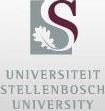Associate Professor Francois Cleophas of the Division of Sport Science at Stellenbosch University's Faculty of Medicine and Health Sciences launched his new book, Physical Education and Physical Culture in South Africa, 1837-1966, in Cape Town this month.
Although it is based on his PhD in sports history, which he completed at Stellenbosch University in 2009, the book incorporates a lot of new information that he uncovered through further archival research and interviews.
Cleophas hopes his book, which is published by Palgrave Macmillan, will stimulate a discussion on physical culture and physical education. “Most people in South Africa don't know the term 'physical culture' anymore," he says. “But physical culture forms the basis of our sport; sport comes from physical culture."
He explains that physical culture is “the human movement of people before they were limited by time, space and place", and says that people used to go to the field to play during the nineteenth century. As time went by, he says, people became spectators.
Cleophas regards this as the main distinction between public culture and sport: there is a 100% participation component in public culture, whereas people are largely spectators in sport.
He asks what happened to physical culture in South Africa: “Is it a reflection of the neoliberal capitalist system that we have now, where sport is about indulgence and extreme performances – and not about the enjoyment of participation and having fun anymore? I hope the book can start a discussion on this."
History of physical education in SA
Another central preoccupation of Cleophas is to trace the history of physical education in South Africa. He took 1837 as his starting point because the Genadendal Teacher Training School was established that year.
He said this school introduced a Moravian physical education pedagogy and combined it with a British physical education system in the late nineteenth century and early twentieth century. This involved activities such as long walks to the vlei and identifying plants and soil types along the way (Moravian) and picking up weights and other exercises at school (British).
Cleophas believes this combination is still worth looking at as a model for South Africa today: “I want to argue that the model those early clubs left can be used for social development in 2025."
Physical Education and Physical Culture also traces the history of physical culture clubs in South Africa and how they were a forerunner of sport. He points out, for example, that the weightlifting champion Ron Eland started out as a member of physical culture clubs in what was then Port Elizabeth (now Gqeberha).
Eland went on to compete in the Olympic Games in London in 1948 and was, in fact, South Africa's first black Olympian (albeit under a British flag because apartheid South Africa refused to allow him to be a member of its weightlifting team).
Muscular Christianity
Another key subject that Cleophas takes up in his book is that of eugenics and what he describes as Muscular Christianity – “how that has informed how we view people's bodies in society, especially black people's bodies".
However, he is not concerned only with researching and documenting these views. He is also intent on examining “how we can change, how we judge and view people's bodies".
Cleophas ends his study in 1966, when the last physical education training programme at mission training colleges was transferred to public training colleges. He notes that one limitation of his book is that it covers such a big landscape that certain important dates and events are brushed over.
However, he plans to address this by writing at least three follow-up studies, including an examination of the contribution of the African Political Organisation (APO) to sport development in South Africa.
Cleophas emphasises that many working class people regarded physical culture activities as an important part of their lives. “The book serves as a foundation for future work for people who want to differ with me about the importance of these clubs or for those who want to take the idea of physical clubs forward," he says.

